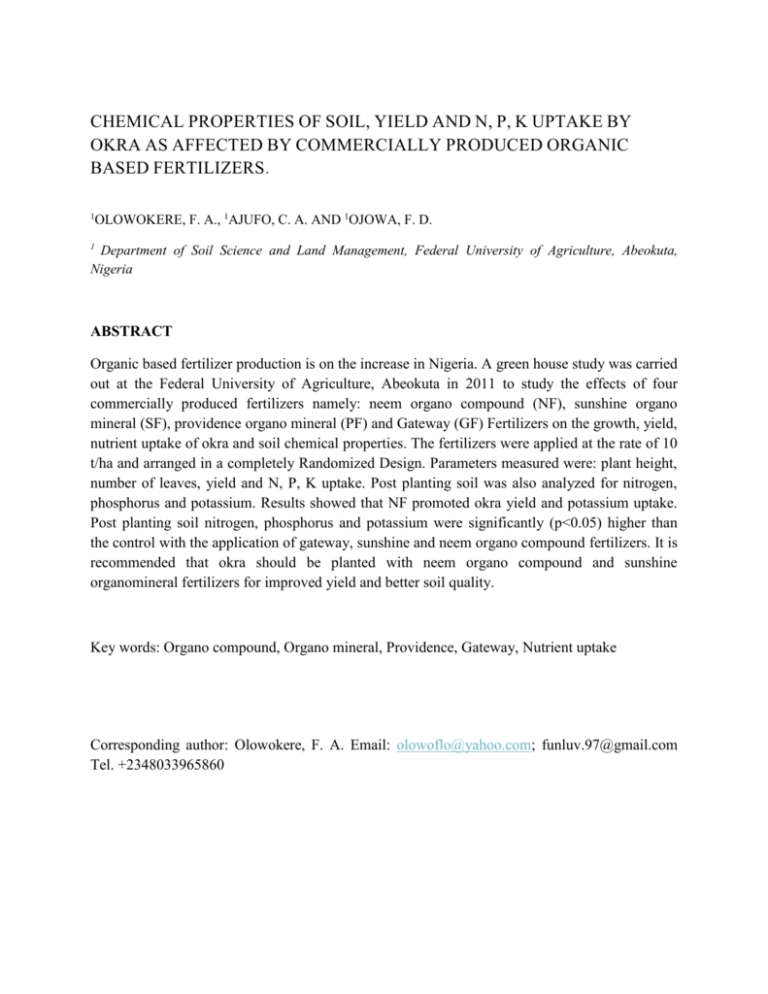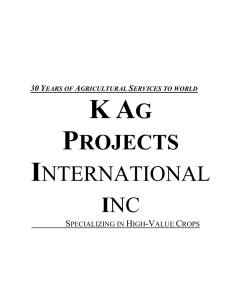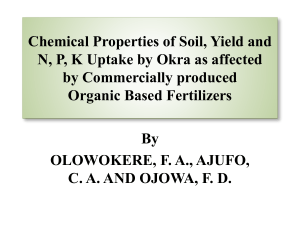GT – Gateway Organic Fertilizer - Soils Science Society of Nigeria
advertisement

CHEMICAL PROPERTIES OF SOIL, YIELD AND N, P, K UPTAKE BY OKRA AS AFFECTED BY COMMERCIALLY PRODUCED ORGANIC BASED FERTILIZERS. 1 OLOWOKERE, F. A., 1AJUFO, C. A. AND 1OJOWA, F. D. 1 Department of Soil Science and Land Management, Federal University of Agriculture, Abeokuta, Nigeria ABSTRACT Organic based fertilizer production is on the increase in Nigeria. A green house study was carried out at the Federal University of Agriculture, Abeokuta in 2011 to study the effects of four commercially produced fertilizers namely: neem organo compound (NF), sunshine organo mineral (SF), providence organo mineral (PF) and Gateway (GF) Fertilizers on the growth, yield, nutrient uptake of okra and soil chemical properties. The fertilizers were applied at the rate of 10 t/ha and arranged in a completely Randomized Design. Parameters measured were: plant height, number of leaves, yield and N, P, K uptake. Post planting soil was also analyzed for nitrogen, phosphorus and potassium. Results showed that NF promoted okra yield and potassium uptake. Post planting soil nitrogen, phosphorus and potassium were significantly (p<0.05) higher than the control with the application of gateway, sunshine and neem organo compound fertilizers. It is recommended that okra should be planted with neem organo compound and sunshine organomineral fertilizers for improved yield and better soil quality. Key words: Organo compound, Organo mineral, Providence, Gateway, Nutrient uptake Corresponding author: Olowokere, F. A. Email: olowoflo@yahoo.com; funluv.97@gmail.com Tel. +2348033965860 INTRODUCTION Organic fertilizers have been reported to increase the yield and quality of crops as well as soil properties. Production of organic based fertilizers help to convert wastes which would otherwise become a nuisance to the environment to environmentally friendly and agriculturally useful materials. Different raw materials which could be of plant or animal origin are used for the production of these fertilizers, these could be used solely or in combination. Their efficiency will depend on the type of raw materials used for the preparation. Examples of raw materials used for the production of the organic based fertilizers are: neem plant/seed, poultry manure, saw dust, rice husk, city refuse, cow, pig dung, crop residues e. t. c. It is therefore necessary to compare the effects of commercially produced organic based fertilizers so as to ascertain their efficiencies. Few sources of commercial organic fertilizer was reported by Adeoye, 2005. Organic farming is on the increase as a result of the activities of organic bodies like National Organization of Organic Agriculture Network (NOAN), Government agencies like Ladoke Akintola University (Mustapha et. al., 2011), Organic Agriculture Project in Tertiary Institutions in Nigeria (OAPTIN) and West African Network of Organic Agriculture (WANOART) With improved awareness of organic agriculture in the country, organic agriculture is now being practiced at a large scale level in Nigeria. Commercial production of organic based fertilizers becomes relevant under large scale farming because the time required for preparation of these fertilizers will be reduced if they can be purchased in large quantity and such times could be used for other activities on the farm. Some of the commercial organic based fertilizers are produced to be crop specific, i. e. the specific nutrients required by a particular crop would have been included in the course of preparation. Materials with additional properties could also be included in the fertilizers. Therefore, it is necessary to compare the efficiency of some of the commercially produced fertilizers in Nigeria. MATERIALS AND METHODS The screen house experiment was carried out at the Screen house of College of Plant Science and Crop Production (COLPLANT), Federal University of Agriculture, Abeokuta. The University falls within longitude 3° 37´ N and 7° 68´ E. Twelve top soils (0-15 cm) were weighed into 15 litre buckets which have been perforated underneath with saucers. \The organic based fertilizers used were: Sunshine organo- mineral, Gateway organic, neem organo compound and Providence organic fertilizers produced by the Ondo State Government, Ogun State Government, National Research Institute for Chemical Technology, Zaria and Olaku Industries Nigeria Limited, Abeokuta respectively. The fertilizers were applied at the rate of 10t/ha which translated to 53.57g/pot by thoroughly mixing it with the soil, the control soil was without fertilizer. the treatments were arranged using Completely Randomized Design and replicated six times. The soil was watered to field capacity every day. Okra (variety- NHAE 47-4) obtained from the National Horticultural Research Institute, Idi-Isin, Ibadan, Oyo state Nigeria was planted at the rate of three seeds per pot at two weeks after fertilizer application. These were thinned to one seedling per pot at two weeks after planting. DATA COLLECTION Data collection started at three weeks after planting and was done weekly for four weeks, the following parameters were assessed: Plant height with the aid of a ruler, number of leaves by physical counting. Okra fruits were harvested at three days interval. PLANT SAMPLING Okra plants were cut at the soil level at eight weeks after planting, these were oven dried at 65°C to constant weight and milled for analysis. PLANT AND SOIL ANALYSIS The milled plant sample was analyzed for nitrogen by Kjeldahl method, phosphorus by vanado molybdate method (Juo, 1982). and potassium by flame photometry. Nutrient uptakes were determined by multiplying dry matter weight by nutrient contents. At the end of the experiment, soil in each pot was thoroughly mixed and sub-sampled for analysis. Nitrogen was determined by Kjeldahl method (Bremner, 1996), particle size by hydrometer method (Udo and Ogunwale, 1986), pH by glass electrode method while organic carbon was by Walkley Black wet oxidation method (Nelson and Sommers, 1989). Available phosphorus was extracted by Bray 1 extraction method (Bray and Kurtz, 1945) and P solution was determined using the molybdenum blue color method (Murphy and Riley, 1962). Calcium, magnesium and potassium were determined by extraction with neutral 1 N NH4OAc, K in the extract was determined by flame photometry while Ca and Mg were determined on atomic absorption spectrophotometer (AAS). STATISTICAL ANALYSIS Data obtained were subjected to the analysis of variance using SAS 2000 package, treatment means were separated using Duncan’s Multiple Range Test (DMRT) at 5 % probability level. RESULTS AND DISCUSSION Results of the particle size distribution and chemical characteristics of pre-planting soil are shown in Table 1. The soil is neutral, organic matter, phosphorus, nitrogen and potassium were low while it is loamy sand in texture. Sunshine organo mineral fertilizer had the highest pH (9.03), followed by this was Providence organic fertilizer (8.41), Gateway organic fertilizer (7.50) while neem organo compound fertilizer had the lowest pH (7.07). Providence organic fertilizer was highest in total nitrogen content (6.72 %) while Gateway fertilizer had the lowest values (2.10 %). Gateway fertilizer had the highest phosphorus content while Sunshine organo mineral fertilizer had the lowest P content (0.86 %). Neem organo compound and Sunshine organo mineral fertilizers were highest in potassium and organic carbon respectively (Table 2). TABLE 1: Particle Size distribution and Chemical Characteristics of pre-planting soil Property Value pH 7.02 Organic matter (%) 0.79 Nitrogen (%) 0.13 Avail. P (mg/kg) 7.13 K (cmol/kg) 0.18 Ca (cmol/kg) 6.16 Mg (cmol/kg) 1.27 Particle Size Sand (%) 77 Clay (%) 14 Silt (%) 9 TABLE 2: Chemical Properties of commercially produced organic based fertilizers used for the experiment Fertilizer Property pH (H2O) N (%) P (%) K (%) O. C. (%) NM 7.07 3.24 3.28 2.73 37.69 GT 7.50 2.10 3.41 2.15 53.95 SH 9.03 2.13 0.86 0.84 76.74 PR 8.41 6.72 1.04 1.41 49.45 NM - Neem Organo Compound Fertilizer GT – Gateway Organic Fertilizer SH – Sunshine Organo-mineral Fertilizer PR – Providence Organic Fertilizer The heights of plants treated with Gateway fertilizer were highest throughout the duration of the experiment, though no significant differences were observed (Table 3). The effect of different commercially produced organic based fertilizers on the number of leaves of okra is shown in Table 4. No significant effect was observed at 3, 5 and 6 weeks after planting while the highest significant (p<0.05) number of okra leaves (6.17) when compared with the control was given by plants with the application of Sunshine organo mineral fertilizer and the lowest value (4.17) was observed on the control. Increase in the number of okra leaves as a result of organo mineral fertilizer application has been reported by Ayeni et. al., 2012 and Olaniyi and Oyerele, 2012. Fertilizer application did not have any significant effect on nitrogen and phosphorus uptake by okra, while plants treated with neem organo compound fertilizer took up significantly (p<0.05) higher level of potassium in comparison with the control (Table 5). Highest potassium content of neem organo compound fertilizer might have been responsible for this observation. A similar trend was observed on okra yield, neem organo compound fertilizer application also significantly (p<0.05) increased okra yield to 46 g/pot above the control. The trend of okra yield in relation to fertilizer application is as follow: NM> SH> PR, GT > C (Figure 1). This may be due to the pelleted form of neem organo compound fertilizer which might have controlled the rate of nutrient release in the fertilizer, thereby making nutrient release slower than the others. The effect of commercially produced fertilizers on the nitrogen, phosphorus and potassium content of post-planting soil is shown in Table 6. Gateway organic fertilizer application significantly (P<0.05) increased the nitrogen content (0.16 %) of post planting soil when compared with the control, this value is however not significantly different from the ones for other fertilizers. All the fertilizers with the exception of Gateway organic fertilizer significantly (P<0.05) increased the phosphorus and potassium contents of post planting soil above the control. The highest P value 947.41 mg/kg) was observed in plots with the application of Sunshine organo mineral fertilizer. Percentage increase in P content over the control by the fertilizers followed this order: SH (69.6%) > PR (65 %) > GT (39.65 %) >NM (22 %). The order of increase in K content was: NM > SH > PR > GT > C. The highest Phosphorus content was obtained on plots with sunshine organo mineral fertilizer application. the highest K value obtained from neem organo compound plots may be due to the fact that the fertilizer had highest K content. CONCLUSION The result of this study shows that neem organo compound fertilizer increased the yield and quality of okra while sunshine organo mineral fertilizer increased the number of leaves. all the organic based fertilizers improved the quality of soil. Okra could be planted with gateway organic, sunshine organo mineral, neem organo compound and providence fertilizers for improved yield, crop and soil qualities. However, it is recommended that this work has to be repeated on the field before making conclusion. TABLE 3: Height (cm) of okra as affected by different types of commercially organic based Fertilizers. Treatment 3 WAP 4 WAP 5 WAP 6 WAP Control 12.43 16.57 24.42 SH 15.45 20.57 28.67 39.00 PR 14.73 18.43 27.50 35.40 NM 14.08 19.62 25.75 39.30 GT 15.82 21.38 29.38 40.42 NS NS NS NS NM - Neem Organo Compound Fertilizer GT – Gateway Organic Fertilizer SH – Sunshine Organo-mineral Fertilizer PR – Providence Organic Fertilizer WAP- Weeks After Planting NS – Not Significant 33.67 TABLE 4: Effect of Different Commercially Produced Organic based Fertilizers on the number of okra leaves. Treatment 3 WAP 4 WAP 5 WAP 6 WAP NM 5.17 5.83ab 6.67 7.33 SH 5.0 6.17a 7.17 7.83 PR 4.67 5.83ab 7.33 7.67 GT 4.17 5.50ab 6.17 8.00 Control 4.17 4.17b 6.50 7.00 NS NS NS Means along a column with the same letter(s) are not significantly different from each other at P<0.05 NM - Neem Organo Compound Fertilizer GT – Gateway Organic Fertilizer SH – Sunshine Organo-mineral Fertilizer PR – Providence Organic Fertilizer WAP- Weeks After Planting NS – Not Significant TABLE 5: N, P and K uptake by okra grown with commercially produced organic based Fertilizers. Treatment N uptake (mg/kg) P uptake (mg/kg K uptake (mg/kg) GT 15.00 2.21 26.46ab SH 28.29 2.50 27.21ab NM 33.50 1.82 40.10a PR 14.25 0.95 26.21ab Control 14.36 1.75 12.33b NS NS Means along a column with the same letters are not significantly different from each other at p<0.05 NM - Neem Organo Compound Fertilizer GT – Gateway Organic Fertilizer SH – Sunshine Organo-mineral Fertilizer PR – Providence Organic Fertilizer WAP- Weeks After Planting NS – Not Significant 50 a 45 40 Fruit yield (g/piot) 35 ab ab 30 ab 25 20 b 15 10 5 0 Control NM Treatment SH PR GT Figure 1: Effect of different commercially produced organic based fertilizers on okra yield. NM - Neem organo compound Fertilizer, SH- Sunshine organo-mineral Fertilizer TABLE 6: Nitrogen, phosphorus and potassium content of post planting soil as affected by different types of commercially produced organic based fertilizers. Treatment N (%) P (%) K (%) GT 0.16a 23.86c 0.16d SH 0.13ab 47.41a 0.36b NM 0.13ab 18.47d 0.43a PR 0.13ab 41.30b 0.27c Control 0.12b 14.4e 0.15d Means along a column with the same letters are not significantly different from each other at p<0.05 NM - Neem Organo Compound Fertilizer GT – Gateway Organic Fertilizer SH – Sunshine Organo-mineral Fertilizer PR – Providence Organic Fertilizer WAP- Weeks After Planting NS – Not Significant REFERENCES Adeoye, G. O. (2005). Organic Agriculture: Areview and possible adoption for food security in Nigeria. Proceedings, 1st National Conference on Organic Agriculture, UNAAB, Abeokuta, Nigeria, 25-28th October, 2005, pp. 3-14. Ayeni, L. S., Adeleye, E. O. and Adejumo, J. O. (2012). Comparative effect of organic, organo mineral and mineral fertilizers on soil properties, nutrient uptake, growth and yield of maize (Zea mays). International Research Journal of Agricultural Science and Soil Science vol. 2 (11) pp. Bremner, J. M. (1996). Total Nitrogen. In C. A. Black (ed.). Methods of soil Analysis. Part 3, Agronomy 9. American Society of Agronomy. Madison Wisconsin, pp 901. Juo, A. S. R. (1982). Automated and Semi automated methods for soil and plant analysis manual series. No.7. Published and Printed by International Institute of Tropical Agriculture (IITA), Ibadan, Nigeria, 33 pp. Murphy, J. and Riley, J. P. (1962). A modified single solution method for the determination of phosphate in natural water. Analytical chemistry. Acta 27: 31-36, 493-497. Mustapha, S. B., Bzugu, P. M. amd Sanusi, A. M. (2012). The need for Organic Farming extension in Nigeria. Journal of Environmental Management and Safety, vol. 3, No. 1, 44-53. Nelson, K. E. and Sommers, L. F. (1982). Total carbon, organic carbon and organic matter In Page, A. L. et. al. (Ed.). Methods of Soil Analysis. Part 2. Agronomy No. 9, Madison Wisconsin U. S. A. Olaniyi, J. O. and Oyerele, T. A. (2012). Growth, Yield and Nutritional composition of Fluted Pumpkin (Telfairia occidentalis) as affected by Fertilizer Types in Ogbomoso, South west Nigeria. Bulletin of Environmental, Pharmacology and Life Sciences, vol. 1 (9). 81-88. Udo, E. J. and Ogunwale, J. A. (1986). Laboratory manual for the analysis of soil, plant and water samples, 2nd edition.







